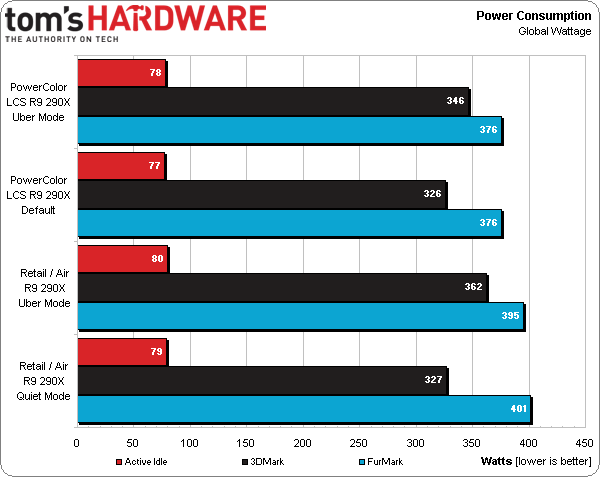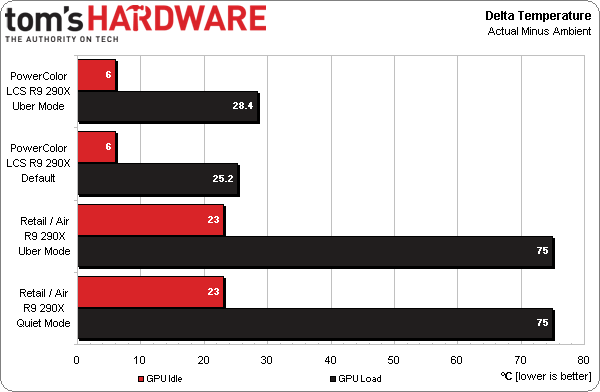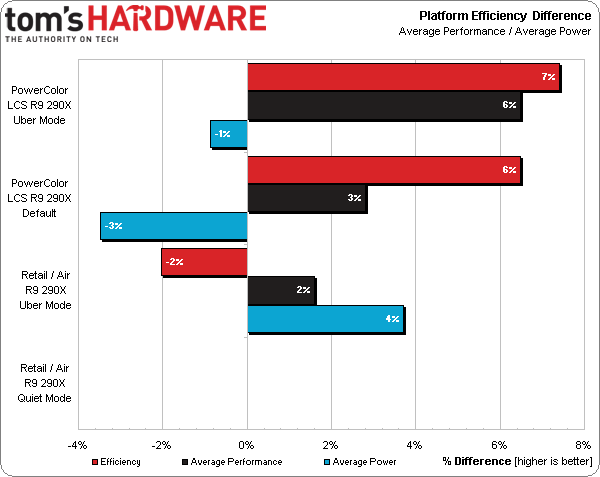PowerColor LCS AXR9 290X: Water Makes Hawaii Comfortable
AMD’s Radeon R9 290X is an incredibly powerful gaming card. Unfortunately, the company's cheap cooling solution results in inconsistent performance and excessive noise. PowerColor’s liquid-cooled LCS AXR9 290X is set to solve both issues with finesse.
Power, Heat, And Efficiency
In today’s test, the liquid cooling system was powered by the platform, pulling around 12 W continuously (18 W at most). Hot cards consume more energy, and that helps explain why the LCS AXR9 290X uses less power, even with the extra cooling parts added to system load.
With AMD’s target temperature of 94 °C, full-load temperatures don’t mean much for air-cooled cards. This chart only indicates an ambient temperature of 18.5 to 19.4 degrees, where I’ve already noted the 18-19 °C temperature as a potential consistency issue.
Temperatures for the liquid-cooled card are exceptionally low. And PowerColor's solution, on its own, pulls around 30 W less as a result (though it gives some of that efficiency back to power the pump).
Now that AMD is overriding the Quiet firmware settings in its driver, it makes less sense that the air-cooled card would still run faster using the Uber firmware (particularly since the Uber setting merely allows faster fan speeds). Even more testing suggested that the source of the added performance was a 0.5° drop in room temperature! It's almost impossible to maintain a workspace with a tighter thermal tolerance, and it's pretty telling that these Hawaii-based boards are so sensitive.
The only performance gains that do make clear sense happen to the LCS AXR9 290X. It always runs cool enough to maintain AMD's peak clock rate ceiling, and rarely encounters a taxing enough load to trigger throttling. Shipping with its BIOS selector set to AMD’s default for air-cooled boards, the PowerColor card picks up a 60 MHz-higher core clock and 100 MHz-faster memory after enabling Uber mode.
Posting greater performance and lower power consumption, the liquid-cooled LCS AXR9 290X naturally achieves better energy efficiency. The reference-class Radeon R9 290X is so inconsistent (in both power and performance measurements) that I no longer wish to use it for any testing purposes, at least at its default fan settings. The only way to make the stock card perform consistently is to push its fan fast enough to maintain consistent clock rates. Of course, then it no longer behaves the way it shipped out from the factory.
Get Tom's Hardware's best news and in-depth reviews, straight to your inbox.
Current page: Power, Heat, And Efficiency
Prev Page Results: Metro: Last Light Next Page Overclocking-
AMD Radeon really? $800?Reply
$100++ from GTX 780 Ti
http://pcpartpicker.com/parts/video-card/#sort=a7&qq=1&c=153 -
Crashman Reply12815459 said:really? $800?that's more than $150 from Asus DCU IIhttp://pcpartpicker.com/parts/video-card/#c=146&sort=a7
It has a $150 cooler (including the back plate, etc).
Of course Asus has a special cooler too. But Asus had the opportunity to drop its price, and the 290x has indeed dropped by $50 to $100 in the past two weeks. Supply is catching up with demand.
Unfortunately for PowerColor, its LCS 290X has been out-of-stock for more than two weeks. So they get stuck with prices that are at least two weeks old, at least until someone gets new inventory and lowers their price.
Sucks to be them, they should have restocked their sellers more quickly :)
But it's still cheaper than a water-cooled 780 Ti :)12815459 said:really? $800?
$100++ from GTX 780 Ti
http://pcpartpicker.com/parts/video-card/#sort=a7&qq=1&c=153 -
outlw6669 Great review Tom!Reply
Did you happen to notice any variability under load for your core speed while overclocked on the LCS card?
I have a Sapphire Tri-X OC R9 290X that is rock solid at its stock 1040MHz, but that starts bouncing the core clock all around when any core overclocking is applied.
With my quiet fan curve, load temps top out around 85°C; well below AMD's specified throttle point of 95°C.
If your liquid cooled cards are solid at 1200MHz, I am curious if Power Tune starts to throttle in a less severe way after going above 70- or 80°C. -
AMD Radeon Reply
Thanks for the explanation, very good review overall :)btw sorry I edited my comment before you posted
It has a $150 cooler (including the back plate, etc).Of course Asus has a special cooler too. But Asus had the opportunity to drop its price, and the 290x has indeed dropped by $50 to $100 in the past two weeks. Supply is catching up with demand.Unfortunately for PowerColor, its LCS 290X has been out-of-stock for more than two weeks. So they get stuck with prices that are at least two weeks old, at least until someone gets new inventory and lowers their price.Sucks to be them, they should have restocked their sellers more quickly :)12815459 said:really? $800?that's more than $150 from Asus DCU IIhttp://pcpartpicker.com/parts/video-card/#c=146&sort=a7 -
TheDane Sapphire R9 290X Tri-X is (very) silent, cheaper, doesn't required a W/C setup, and installation is much easier. Also the LCS card here requires a wide case due to its height!Reply -
Crashman ReplyGreat review Tom!Did you happen to notice any variability under load for your core speed while overclocked on the LCS card?I have a Sapphire Tri-X OC R9 290X that is rock solid at its stock 1040MHz, but that starts bouncing the core clock all around when any core overclocking is applied.With my quiet fan curve, load temps top out around 85°C; well below AMD's specified throttle point of 95°C.If your liquid cooled cards are solid at 1200MHz, I am curious if Power Tune starts to throttle in a less severe way after going above 70- or 80°C.
Power throttling occurs under Furmark and not much else, and can be eliminated by increasing the power threshold.
...and toasts your CPU. Please read the first page of this review, thanks!12815581 said:Sapphire R9 290X Tri-X is (very) silent, cheaper, -
outlw6669 Reply
Odd, this happens with a +50% power limit and tested with the Metro Last Light benchmark :/12815634 said:Power throttling occurs under Furmark and not much else, and can be eliminated by increasing the power threshold.
Thanks for confirming that your test card was not throttling; back to troubleshooting my setup! -
Crashman Reply
Remember that the LCS test card runs cooler than an air-cooled card, and that lower temperatures significantly lower power consumption :)12815667 said:
Odd, this happens with a +50% power limit and tested with the Metro Last Light benchmark :/12815634 said:Power throttling occurs under Furmark and not much else, and can be eliminated by increasing the power threshold.
Thanks for confirming that your test card was not throttling; back to troubleshooting my setup!
-
outlw6669 Reply12815705 said:Remember that the LCS test card runs cooler than an air-cooled card, and that lower temperatures significantly lower power consumption :)
Good point; I will have to retest with a cooler fan curve.
Not sure if this will be the issue though as even a 20MHz bump to the core, and +50% power limit added to this, causes throttling with under 85°C temps.
Thanks for the thoughts! -
ddpruitt ReplyAs air temperatures climbed into the 20s (Celsius) inside the case
Actually with a low room temp it'll still affect results quite a bit. I can push higher clocks in the winter with a lower room temp than in the summer (and forget it when we hit 40C, no OCing unless the Air's cranked up all the way). You might want to retest once you're able to heat up the office to see how the temps are affected (both on the air cooled and water cooled setups).




